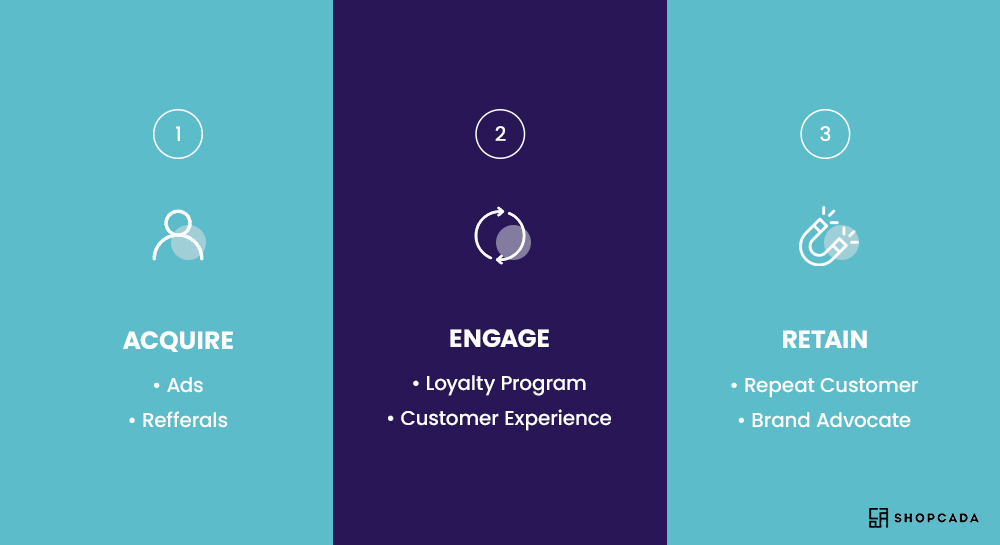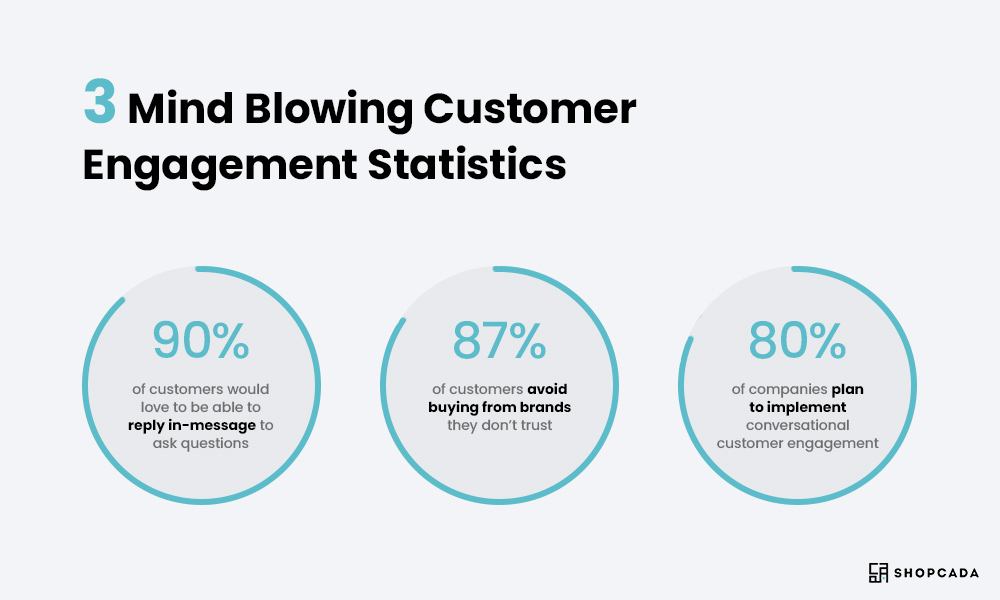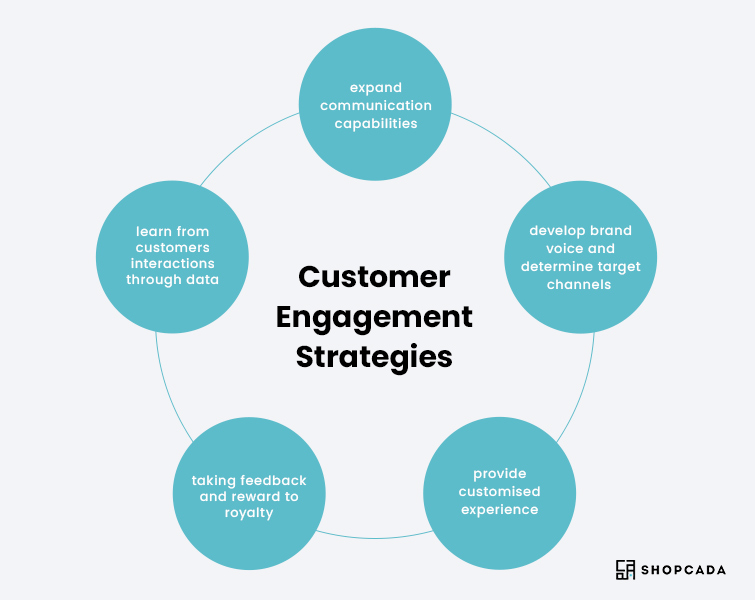Customer Engagement: 100% Simplified Beginner Walkthrough
Customer engagement did not fully emerge until the digital era. As two-way communication between customer and brand developed through online channels, engagement became more prevalent and visible. Of course, engagement can occur in person as well as through traditional communication channels.
Wouldn't it be nice to know how your customers feel about the job you're doing if you owned a business? Without a doubt. But how can you learn what your customers want or need from you if you aren't psychic? By conversing with them! This is what we call customer engagement in business, and it's more important than ever.
To define customer engagement, let's start with the basics and answer another question: what is an engaged customer? What exactly do companies and thought leaders mean by customer engagement? That depends.
Definitions abound on the internet, but they all serve to highlight a few different aspects of customer engagement.
According to Customer.com, CE is incremental and holistic, made up of many small interactions, each of which has an impact on the whole:
"Customer engagement is the depth of a customer's relationship with a brand." With each interaction, it can be strengthened - or weakened. Making a purchase, writing a review, or joining a loyalty programme all increase the depth of customer engagement and become more mutually beneficial the more closely a brand can connect with customers' preferences."
Academic Linda Hollebeek defines it in terms of personal investment in the Journal of Strategic Marketing:
"The level of a customer's cognitive, emotional, and behavioural investment in specific brand interactions is defined as CBE." Furthermore, three key CBE themes have been identified: "immersion," "passion," and "activation."
Amazon Web Services connects engagement and loyalty, framing it as a business-led activity:
"Customer engagement refers to the practises that businesses use to keep users returning to their applications." In today's digital marketplace, where an increasing number of brands compete for a finite amount of customer attention, increasing customer engagement is critical."
In general, customer engagement (CE) or customer-brand engagement (CBE) refers to a customer's relationship with a company. When we look at customer engagement, we are investigating the quality of that relationship, whether it is positive or negative, how customer participation occurs, and how frequently it occurs.
For most businesses, investigating the topic will also entail attempting to comprehend how customer engagement relates to business success in terms of sales, loyalty, and whether the customer is a detractor or promoter of the brand.

Customer engagement dimensions could include:
-
Longevity: The amount of time that interactions are spread out over.
-
Proactivity: Whether a customer interacts with a brand on their own, without being prompted.
-
Repetition and frequency: Are the interactions frequent and similar, or are they sporadic and varied?
-
Context: The situation in which interactions occur, such as after purchase, during consideration, only when a promotion is running, and so on.
-
Volume: The amount of interaction that occurs throughout the customer journey.
While that may be very detailed, the simplicity of it all is that an engaged customer uses your product regularly, makes use of the majority of the features, and can provide genuine feedback on how your product has improved their lives. Or, to put it another way, they USE your product or service. Almost all of the time. And they're so invested in what you're offering that switching vendors would be nearly impossible.
Fun fact, did you know that 89% of customers would appreciate the ability to converse with your brand? Your customers are eager to interact with you. The key is to know where and how to start meaningful conversations.
Fortunately, there are numerous excellent ways to become proactive and begin reaping the benefits of powerful two-way interactions. When a customer contacts you with a problem, they expect you to do more than just respond.
What Is Customer/Consumer Engagement?
Hold up, didn’t we just cover this? Well, yes, and no. We covered the definitions of it, but what we want to do now is to look deeper into what it means.
Let’s start with a hook - A whopping 86% of customers are willing to pay more for exceptional experiences. Is your engagement strategy ready to provide that?
Customer engagement is the process by which brands develop relationships with their customers through various communication channels. Businesses learn how to provide the best value to their customers by engaging in consistent and ongoing dialogue with them.
Remember that this does not always imply selling something. The majority of interactions are non-transactional, like sharing the following content:
-
Materials for education
-
Individualised self-help resources
-
Recommendations or helpful reminders
The relationship begins before and continues after the point of sale. It is critical to meet customers where they prefer to talk or get information to see results.
You need a way to tell if the content you're creating for your audience is working. And the best determining factor is what customers do after they consume your content.
Do they engage with your Facebook posts? Do you interact on Instagram? Do you want to retweet your content on Twitter?
Once you know what they think and how they feel about you, you can use that information to predict their future loyalty.
A client engagement strategy should include any type of communication you can establish with a client to teach them how to use your product or service to its full potential.
Consider client engagement to be a never-ending conversation in which you get to know your customers better and assist them in achieving their goals through the use of your product.
Why Is Customer/Consumer Engagement Important?
It almost seems silly to write this section because the importance of customer engagement appears to be the most obvious thing in the world. You acquire, engage, and retain. There's no getting around it.

Customer engagement has several advantages:
Reduced churn. Customers who are unsure of how to approach your product or why they require it will leave in the blink of an eye. Customers who are engaged will stay with you for a long time.
-
Loyalty. The more loyal your customers are the more favourable reviews and endorsements you can expect. And these things are more valuable than gold because they will bring you new customers through word of mouth without you having to do anything.
-
More upsells and cross-sells. Loyal customers are far more likely to purchase from you again and again, upgrade their accounts, and use every feature your product has to offer.
-
Customer insights. By maintaining constant contact with customers, you can ensure that they will be more eager to share their ideas and insights with you. This, in turn, will help you prioritise your product development and marketing campaigns.
It's all very simple. Customers who are engaged are loyal. Customers who are loyal to you bring in more customers. They are all more likely to make additional purchases from you. And all of this leads to what every business owner desires: increased sales and revenue.
Customer engagement may sound like a panacea for all business problems and issues at this point, and that's because it is. Communication with your clients and sharing your vision with them is the only way to build strong bonds.
So, now that we've answered all of the whys, we can move on to the how — how to engage with your customers and which channels to use.
Hold On!
To understand what customer engagement entails, we must first disentangle it from a few related concepts.
Customer Engagement VS Customer Experience
CX encompasses everything that a customer encounters with a brand, from seeing billboard advertisements alongside the highway to visiting the restrooms of a flagship store.
Working on CX entails putting yourself in the shoes of the customer and thinking about how to provide the best possible experience across all touchpoints.
Customer engagement, on the other hand, incorporates the customer's agency and choice, rather than just what the brand presents to them. The customer is viewed as an active participant in CE rather than a passive recipient of an experience. CE investigates how they react and respond, how they contact you, their relationship with your content and marketing, how they discuss you with others, and whether they promote or detract from you. Simply put, it's a conversation.
Customer Engagement Vs. Customer Satisfaction
Customer satisfaction and customer engagement may appear to be two sides of the same coin, but the overlap should not be overlooked.
A satisfied customer is unlikely to become engaged. They could be a loyal customer at your hardware store for life but never participate in a loyalty programme, follow the brand on social media, or file a complaint. Similarly, an engaged customer may make few purchases from a luxury department store but spend hours chatting on a brand-owned forum or engaging with the company's aspirational Instagram posts.
As a result, customer engagement is not synonymous with customer satisfaction. Customer satisfaction, on the other hand, can be an outcome of and a precursor to customer engagement.
How Do You…Customer Engage?

Conversations are no longer limited to the phone. People use at least four different communication channels on average, including:
-
Texting
-
Email
-
Social networking sites
-
Websites
-
Forums for the community
Meeting customers in their preferred communication channels is essential for successful engagement.
"But wait," you might say, "what about customer satisfaction and customer experience?" Let us distinguish between customer engagement and other related concepts.
Distinction Between Customer Engagement, Customer Experience, and Customer Satisfaction?
Customer engagement, customer experience, and customer satisfaction all share many similarities. They collaborate to provide more value to the customer. While the three concepts overlap, the following are the main distinctions:
Customer engagement refers to how your customers interact with your brand through various communication channels:
-
The customer takes an active role in the relationship.
-
There is a dialogue between the customer and the brand.
-
It takes place before, during, and after a transaction.
-
It can have an impact on whether or not your customer purchases something or returns for more.
-
Interacting with your company's social media posts, completing customer satisfaction surveys, or subscribing to email notifications or customer loyalty programmes are all examples.
The customer experience (CX) refers to your customers' perceptions of all interactions with your brand:
-
CX assesses how a customer reacts to your brand's actions.
-
It isn't just about the shopping experience.
-
Examples include how a customer feels after contacting customer service or a memorable in-store shopping experience.
Customer satisfaction is a measure of how satisfied your customers are with your company:
-
It is influenced by customer experience and engagements, but it is not always synonymous with engagement.
-
It is typically measured following a sale or support interaction.
-
Customers' satisfaction, for example, can translate into repeat purchases or positive online reviews for your company.
"Geez, these all sound important," you might think, and you'd be right. Any great company will not overlook any of these!
Speaking with your customer before, during, and after a sale improves the customer experience and increases customer satisfaction.
In other words, developing world-class customer engagement can have the greatest impact on your business. Let's dig deeper into why you should prioritise it.
But Why Do You Really Need It?
Wouldn't you rather have customers who are eager to tell you what they want rather than guessing? Developing rapport with your customers can provide you with valuable insights into the customer journey.
As an example, suppose you need to shop for insurance.
Scenario 1:
You've seen Insurance Company A's commercials and online advertisements.
Perhaps they've even sent you an email with a coupon for "10% off for a limited time only."
You go to their website, look through their plans, and compare their prices to those of a competitor.
Perhaps you have questions about their prices or their various plans. You're on your own without someone to guide you.
Scenario 2:
Your friend raved about their positive experience with Insurance Company B.
You visit their website, and a chatbot assists you.
The chatbot arranges a live consultation with a representative to determine the best plan for you.
A day after the call, you receive a text asking how your phone call went and an email with additional resources for financial management.
You are so impressed that you complete the satisfaction survey (with a 10/10) and tweeted about Insurance Provider B.
Provider B responds to your Tweet by reminding you to sign up for their customer loyalty programme to receive notifications about discounts and other perks.
If your only interactions with a company are transactional (as with Insurance Provider A), your relationship will be limited. That could work, but isn't there something missing?
We see how active listening, conversations across multiple channels, and helpful, non-transactional engagements create a more fulfilling customer experience, as well as better outcomes for both parties, with Insurance Provider B.
Authentic conversations with your customers aid in the development of true brand loyalty and the enhancement of your brand's reputation. Customers turn into partners, and partners spread the word about your company!
This gradually expands your customer base and opens the door to new growth opportunities.
Now that we've seen some of the advantages of customer engagement, let's take a closer look at what goes into a successful engagement strategy.

What To Know & Look Out For
Building a great engagement strategy, like any other construction project, necessitates the proper structure and tools. You wouldn't try to build a house out of duct tape and glue, would you?
Communication is essential in any relationship. The relationship between a brand and its customers is no different. Increasing touchpoints across the channels your customers use the most is a great place to start when it comes to developing deeper connections.
Step 1: Choose the appropriate technology to expand your communication capabilities.
A customer engagement platform enables rich, interconnected engagements across multiple channels, such as:
-
Customer service via multiple channels
-
Marketing through conversation
-
Commerce through conversation
-
Customer Experience Transformation
You can then concentrate on the next step with the right technology.
Step 2: Develop your brand voice and determine your target channels.
A consistent and personal tone of voice across channels creates a consistent experience that inspires trust and makes customers feel at ease.
Following that, you'll need to understand which channels are most important to your customers. Why invest in communications support on a channel that your customers do not use? Some social messaging channels, for example, are very popular in some countries but rarely used in others. You probably don't need to support a particular messaging app if you don't have customers in that area!
It's time to move on to the next step once you've interacted with your target customers!
Step 3: Provide customised experiences.
From customer service to product demonstrations, everything should be tailored to the individual customer. A customer engagement platform will assist you in tracking each customer interaction and passing data between systems so that you can provide personalised support with each conversation.
Step 4: Solicit customer feedback and reward customer loyalty.
You are not listening to your customers if you are not monitoring their experience through satisfaction surveys or feedback forms. They will have the most actionable insights that you can use to constantly improve!
Customers appreciate it when you go above and beyond for them. Encourage customer loyalty by providing reward programmes or giveaways in exchange for feedback participation.
After you've launched your conversational customer engagement programme, your next focus should be on customer data.
Step 5: Gather data to learn from your customer interactions.
You want to ensure that your conversations have an effect. This is where having a unified customer communications solution can truly pay off. We'll go over what metrics you can use to measure your success and stay ahead of the competition in the future.
Metrics of Customer Engagement
A solid customer engagement platform can provide insight into the efficacy of your campaigns and interactions across channels.
Your overall business objectives may differ, but these KPIs will aid in measuring the effectiveness of your engagement strategy.
Leading indicators of customer engagement
Leading indicator metrics for customer engagement may be considered soft KPIs, but they provide a good indication of where you're going. It's useful information for identifying opportunities and making improvements to your engagement strategy as you go.
These are some examples:
-
Rates of email open and response
-
Rates of text read and response
-
Participation in social media
-
Visits to your website regularly or monthly active users (MAU)
-
Spending time on your website and specific pages
-
Rates of conversion
-
Call and speak with customer service.
Use leading indicators as a guide to determine where and how you can provide the most value to your customers.
Customer engagement indicators that lag
Lagging indicators look back at what has already occurred in your business and can show how far you've come over time. This is your opportunity to demonstrate the impact of your customer engagement strategy on the business using metrics that are critical to CX's success.
Among the lagging indicators are:
-
Customer satisfaction (CSAT)
-
Net Promoter Score (NPS)
-
Customer effort score (CES)
-
Customer churn and retention rates
-
Customer lifetime value (CLV)
If you incorporate meaningful conversational engagement into your brand DNA, you should eventually notice a positive correlation between your customer engagement metrics and revenue growth.
Closing Words
Customer engagement is a complex process that necessitates extensive resources and dedication. To stay on top of things, you must choose the right channels to communicate with users, segment the audience to deliver relevant and personalised experiences to each individual, and constantly collect feedback.
That is why it is critical to select the right customer engagement platform that will cover all channels and accommodate the necessary data for precise targeting. Study your audience and interact with it regularly to ensure that you retain everyone you can and learn from those who churned.

